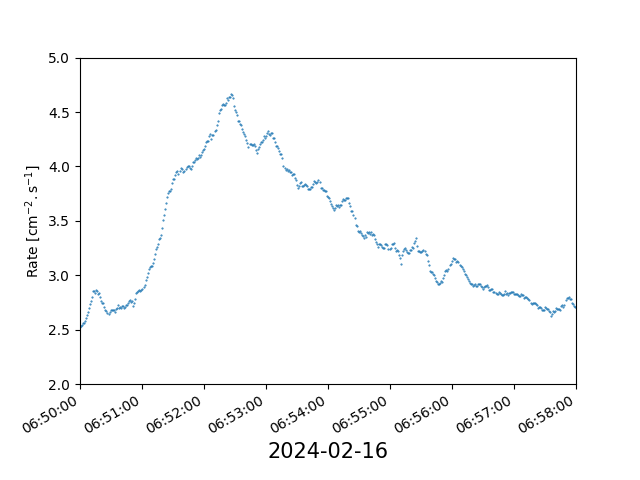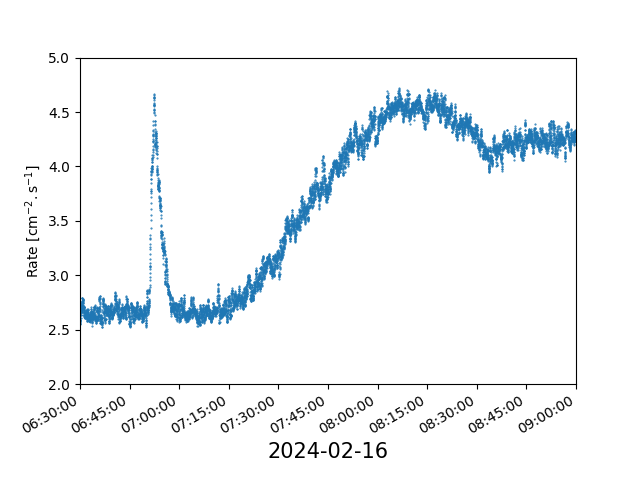IoW_20240426 - Gaia
Image of the Week
A textbook solar eruption detected by Gaia
Figure 1. A solar flare of magnitude X2.5 as seen in the charged particle rates measured by the Gaia mission's camera. There is an initial peak of a few minutes due to the flare event followed by a longer charged particle signal over several hours. Credits: ESA/Gaia/DPAC - CC BY-SA 3.0 IGO. Acknowledgements: Ed Serpell.
Onboard Gaia, the computers that process the images automatically identify and count the tracks left by the passage of charged particles through the detectors. These computers send a constant stream of charged particle counters to the operators on the ground where they are converted to particle rates and used for space radiation monitoring. In 2024 the sun is now at the peak of its eleven year cycle of activity, this means lots of sunspots, lots of flares and lots of charged particles.
In early February 2024 a large and magnetically complex sunspot was seen to move across the face of the sun, as seen from the Earth. Finally, on 16 February this spot erupted, sending out a flash of high energy photons and a burst of high energy particles. The event was registered as an X2.5 flare by measuring the x-ray radiation that was emitted. Fortunately, this event occurred as the sunspot was disappearing from view, right on the western edge of the disk as seen from the earth. This position meant that most of the potentially damaging radiation was not directed towards Gaia. However, some particles did arrive at the spacecraft and were detected passing through the CCDs. The measured particle rates are shown in the image above.
Energetic events at sunspots come in many different flavours, some last for hours, some only for minutes. The signal from this event, as seen in the Gaia particle rates, is a textbook example of an impulsive, short duration, energetic solar event. There is a clear initial spike due to a photon signal that is followed by a classic particle signal. The duration of the photon signal was less than the time needed for the particles to arrive, so there is a clear distinction between the two.
Description of a solar flare from "A summary of major solar proton events", M. A. Shea and D. F. Smart, Solar Physics 127: 297-320, 1990. The similarities to the Gaia data are remarkable. Credits: M. A. Shea and D. F. Smart, Solar Physics 127: 297-320, 1990
Although the flare was characterised as X2.5 due to its x-ray energy, it is unlikely that x-rays could penetrate through to the Gaia CCDs. However, it is known that Gaia can function as a gamma ray detector therefore it is likely that the first spike was due to secondary electrons from incident gamma ray photons. The photons were able to travel directly from the sun to Gaia in about 8.3 minutes, at the speed of light. The later charged particle signal would have been due to solar material, so mostly protons and electrons. The charged particles would have been constrained by the interplanetary magnetic field to travel in longer, spiralling arcs. Even the very highest energy particles that were travelling at close to the speed of light took some extra time to arrive as a result of this extended path.
Zoom into the detail of the data. Left: The photon signal. Right: The separation between the photon and the charged particle signal.
Further reading on topics related to Gaia flight operations or Gaia capturing activty through its telemetry?
- Goonhilly station steps in to save Gaia science data
- Gamma-Ray Burst detection from Lagrange 2 point by Gaia
- Gaia's first photo shooting of the James Webb Space Telescope
- Whitehead Eclipse Avoidance Manoeuvre
- Gaia spots a sunspot
- Lunar transit temperature plots
- Gaia's sensors scan a lunar transit
Story written by Ed Serpell.
Credits: ESA/Gaia/DPAC, Ed Serpell, Gaia flight operations team.
[Published: 26/04/2024]
- Removed a total of (11) style text-align:center;
- Removed a total of (4) style text-align:justify;
Image of the Week Archive
- Removed a total of (1) border attribute.
- Removed a total of (1) cellpadding attribute.
- Removed a total of (1) cellspacing attribute.








































 Sign in
Sign in
 Science & Technology
Science & Technology



